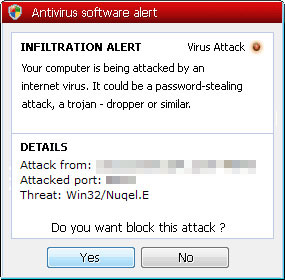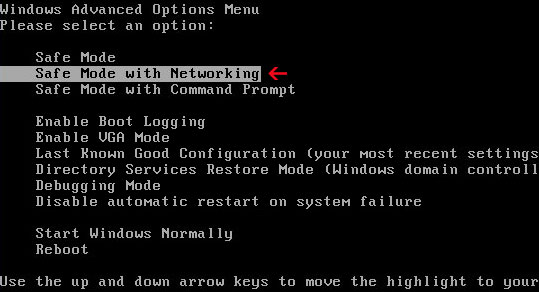
AntiVira Av is a copy of Antivirus .NET. It changes LAN settings and configures your computer to use a proxy server that displays a fake security warning instead of requested website. The rogue program will also randomly open web pages containing explicit/adult content.
Internet Explorer Warning - visiting this web site may harm your computer!
Most likely causes:
- The website contains exploits that can launch a malicious code on your computer
- Suspicious network activity detected
- There might be an active spyware running on your computer

Here are some of the fake security alerts that you will probably see if your computer gets infected with AntiVira Av:
Antivirus software alert. Virus attack!
Your computer is being attacked by an internet virus. It could be a password-stealing attack, a trojan-dropper or similar.
Threat: Win32/Nuqel.E
Do you want to block this attack?

Windows Security Alert
Windows reports that computer is infected. Antivirus software helps to protect your computer against viruses and other security threats.

When the rogue terminates the program it displays the following error message:
Security Alert
Virus Alert!
Application can't be started! The file [program_name].exe is damaged. Do you want to activate your antivirus software now?

AntiVira Av related websites: poprog.net, shopllbo.com. The fake av redirects users to one of these websites to purchase a license of AntiVira Av. As you can see, there are three versions of this malware: AntiVira Av Limited, AntiVira Av Plus and AntiVira Av Full. Thesafepc.com is also related to this fraud.

Antivira Av runs from your Temp folder. It's a single, randomly named file in a randomly named folder. In order to remove this rogue security from your computer you will have to restart your computer in safe mode with networking, disable a proxy server and download malware removal tool. For more information, please follow the removal instructions below. If you do get duped into installing this rogue program, don't panic. And do not hand over any money. If you have already purchased it, please contact your credit card company and dispute the charges. If you need help removing Antivira Av, please a comment. Look out for this piece of malware. Good luck and be safe online!
AntiVira Av removal instructions (in Safe Mode with Networking):
1. Reboot your computer is "Safe Mode with Networking". As the computer is booting tap the "F8 key" continuously which should bring up the "Windows Advanced Options Menu" as shown below. Use your arrow keys to move to "Safe Mode with Networking" and press Enter key. Read more detailed instructions here: http://www.computerhope.com/issues/chsafe.htm

NOTE: Login as the same user you were previously logged in with in the normal Windows mode.
2. Launch Internet Explorer. In Internet Explorer go to: Tools->Internet Options->Connections tab. Click Lan Settings button and uncheck the checkbox labeled Use a proxy server for your LAN. Click OK.

3. Download free anti-malware software from the list below and run a full system scan.
NOTE: in some cases the rogue program may block anti-malware software. Before saving the selected program onto your computer, you may have to rename the installer to iexplore.exe, explorer.exe or winlogon.exe. With all of these tools, if running Windows 7 or Vista they MUST be run as administrator. Launch the program and follow the prompts. Don't forget to update the installed program before scanning.
4. New threats appear every day. In order to protect your PC from such (new) infections we strongly recommend you to use ESET Smart Security.
Alternate AntiVira Av removal instructions using HijackThis (in Normal mode):
1. Download iexplore.exe (NOTE: iexplore.exe file is renamed HijackThis tool from TrendMicro).
Launch the iexplore.exe and click "Do a system scan only" button.
If you can't open iexplore.exe file then download explorer.scr and run it.
2. Search for such entry in the scan results:
R1 - HKCU\Software\Microsoft\Windows\CurrentVersion\Internet Settings,ProxyServer = http=127.0.0.1:52371
O4 - HKCU\..\Run: [SET OF RANDOM CHARACTERS] %Temp%\[SET OF RANDOM CHARACTERS]\[SET OF RANDOM CHARACTERS].exe e.g. hdrwpsjf38shef.exe
Select all similar entries and click once on the "Fix checked" button. Close HijackThis tool.
OR you may download Process Explorer and end AntiVira Av process:
- [SET OF RANDOM CHARACTERS].exe, e.g. hdrwpsjf38shef.exe
NOTE: in some cases the rogue program may block anti-malware software. Before saving the selected program onto your computer, you may have to rename the installer to iexplore.exe, explorer.exe or winlogon.exe. With all of these tools, if running Windows 7 or Vista they MUST be run as administrator. Launch the program and follow the prompts. Don't forget to update the installed program before scanning.
4. New threats appear every day. In order to protect your PC from such (new) infections we strongly recommend you to use ESET Smart Security.
Associated AntiVira Av files and registry values:
Files:
- %Temp%\[SET OF RANDOM CHARACTERS]\
- %Temp%\[SET OF RANDOM CHARACTERS]\[SET OF RANDOM CHARACTERS].exe
C:\Documents and Settings\[UserName]\Local Settings\Temp (in Windows 2000/XP)
C:\Users\[UserName]\AppData\Local\Temp (in Windows Vista & Windows 7)
Registry values:
- HKEY_CURRENT_USER\Software\[SET OF RANDOM CHARACTERS]
- HKEY_CURRENT_USER\Software\Microsoft\Internet Explorer\Download "RunInvalidSignatures" = '1'
- HKEY_CURRENT_USER\Software\Microsoft\Internet Explorer\PhishingFilter "Enabled" = '0'
- HKEY_CURRENT_USER\Software\Microsoft\Windows\CurrentVersion\Internet Settings "ProxyOverride" = ''
- HKEY_CURRENT_USER\Software\Microsoft\Windows\CurrentVersion\Internet Settings "ProxyServer" = 'http=127.0.0.1:52371'
- HKEY_CURRENT_USER\Software\Microsoft\Windows\CurrentVersion\Internet Settings "ProxyEnable" = '1'
- HKEY_CURRENT_USER\Software\Microsoft\Windows\CurrentVersion\Policies\Associations "LowRiskFileTypes" = '.exe'
- HKEY_CURRENT_USER\Software\Microsoft\Windows\CurrentVersion\Run "[SET OF RANDOM CHARACTERS]"
- HKEY_CURRENT_USER\Software\Microsoft\Internet Explorer\Download "CheckExeSignatures" = 'no'















0 comments:
Post a Comment